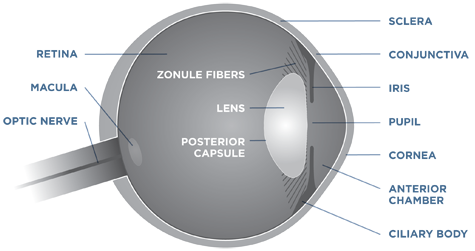
About Cataracts
A cataract is a clouding of the lens in the eye that affects vision. It can occur in one or both eyes. Most cataracts are related to aging. People can have an age-related cataract in their 40s and 50s, but these tend to be small and don’t often affect vision. It is after age 60 that most cataracts affect vision. By age 80, more than half of all Americans either have a cataract or have had cataract surgery.1
What is a lens?
Your lens is a clear part of your eye that helps focus light, or an image, on the retina. The retina is the light-sensitive tissue at the back of your eye. In a normal eye, light passes through the transparent lens to the retina, where it is changed into nerve signals that are sent to the brain. The lens must be clear for the retina to receive a sharp image. If the lens is cloudy from a cataract, the image you see will be blurred.

How is a cataract formed?
Your eye lens is made of mostly water and protein. The protein is arranged in a precise way that keeps the lens clear and lets light pass through it. But as you age, some of the protein may clump together and start to cloud a small area of your lens. This is a cataract. Over time, the cataract may grow larger and cloud more of the lens, making it harder to see.
What causes a cataract?
No one knows for sure what causes cataracts. Some researchers suspect smoking, alcohol use, poor nutrition, diabetes and prolonged exposure to sunlight increase a person’s risk for developing cataracts. Other believe that the protein in the lens simply changes as a result of wear and tear over the years.
How can cataracts affect your vision?
Age-related cataracts can affect your vision in two ways:
- Clumps of protein can reduce the sharpness of images reaching your retina, so vision becomes blurred or dull.
- Your clear lens slowly changes to a yellowish/brownish color, adding a brownish tint to your vision. This tinting doesn’t affect the sharpness of images, but eventually you may not be able to identify blues and purples.
How is a cataract detected?
A cataract is detected through a comprehensive eye exam that may include:
- Visual acuity test. This eye chart test measures how well you see at various distances.
- Dilated eye exam. Drops are placed in your eyes to widen, or dilate, the pupils. Your eye care professional uses a special magnifying lens to examine your retina and optic nerve for signs of damage and other eye problems. After the exam, your close-up vision may remain blurred for several hours.
How is a cataract treated?
The symptoms of early cataract may be improved with new eyeglasses, brighter lighting, anti-glare sunglasses, or magnifying lenses. If these measures don’t help, surgery is the only effective treatment. Surgery involves removing your cloudy lens and replacing it with a clear artificial lens.
If you and Dr. Pilkinton decide surgery is right for you, there are several different types of eye measurements, replacement lenses and methods of performing cataract surgery — and which you choose will directly affect your vision after surgery.
To learn about the Most Advanced Cataract Surgery (MACS) options, go to MACS. You can also compare MACS with conventional cataract technologies in our Technology Comparison.
References
1 National Eye Institute of the National Institutes of Health.
Life
Looks
Sunnier
Wouldn’t it be great to read your book and watch the grand kids play on the beach without having to change glasses. Ask Dr. Pilkinton about Blended Vision and how it can make your life fun in the sun.

